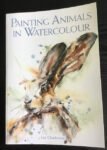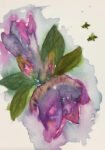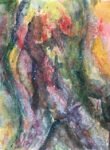Another birthday book. This is a 112 page long paperback. So slightly short on…

Billy Showell’s Botanical Painting In Watercolour
It’s a book review today. This is a book that I spotted in the shops on my most recent trip to London. I’ve never really given botanical painting a go but I thought book looked interesting enough and even useful enough for non botanicals for it to be worth putting on my Amazon wishlist, albeit near the bottom. And then, last week, the price of the book plummeted to £12. I thought this was too tempting a bargain to ignore for a 192 page glossy hardback, so ordered a copy while the going was good.
The book feels like the Jean Haines books, not because it’s a hardback by Search Press or because flowers play a major part but because the contents page seems superfluous. The book feels more like one long journey than a list of chapters. Still, let’s talk structure. We have:
- about 25 pages of introduction with chapters on materials, getting started and working from life. The last of these chapters is very specific to botanical painting with recommendations on how to make flowers and fruit stay fresh throughout a long painting exercise.
- about 20 pages taken up by chapters on observation and drawing. Self explanatory.
- then we have the main bulk of the book with 95 pages on painting with lots of mini demos and lots of completed works to discuss. There are separate chapters on using a brush, painting techniques, troubleshooting, painting detail, adding pattern, creating texture, painting multi-headed flowers and painting from enlarged photos but, as I said, this feels more like one long journey than like a series of chapters
- then about 40 pages on colour mixing, with lots of example paintings to illustrate her advice. Much of this is with reference to Billy’s colour palette but there’s plenty of more general advice too and, honestly, if you buy this book you’re probably already at the stage where you can translate advice about Billy’s palette into ideas about what to do with your own
- and we finish with about 10 pages on composition and about 5 on stretching paper
I have to say I do like the structure of this one. It felt weird at first for the colour mixing to be so late in the book but the more I thought about it, the more I realised that the ability to observe and paint detail is more key to botanical paintings than the ability to mix exactly the right colour. The long middle section with its mini demos could be accused by some of being a bit repetitive. For the knitting pattern brigade, for whom every demo is a set of instructions to be followed, this won’t be the case: every flower is different. But to someone like me, reading through them and looking to pick up new ideas, it can get repetitive. After seeing the first few examples, I get that I need to start wet into wet, lift out highlights, use tiny brushes for detail, etc. I felt like I was learning less and less from each demo as I read through them. On the other hand, repetition like this does get the message through. I think they call it osmosis. And, maybe it was just me, but I’d rather the photos had been taken more close up: this would have helped me understand the techniques a bit better.
The author does have a voice, although not as enthusiastic a voice as some others. I didn’t come out at the end of the book desperately wanting to try out some botanical painting, although I expect I’ll give it a giant some point. On the other hand, readers going into this book with a well developed passion for botanicals might feel differently. Maybe I was just a cool lead.
Perhaps the most important question is whether there’s anything in this book that will help me in non botanical painting. And, you know what? I think there is. There’s lots to pick up on observing and painting detail that could conceivably also apply to painting (for example) portraits. It’s like an introduction to painting in a different mindset. A reminder that watercolour doesn’t have to be all about capturing the light and the feeling and ignoring the detail: there is an alternative way forward. And there’s also something about a type of brush that I may have to invest in that Billy uses a lot for tidying up edges.
OK. Crunch time. What do I really think of this book? Well, while it didn’t arouse my botanical passions, it’s the only botanical painting book I’ve ever seen that I’ve been tempted to buy. It feels to me like a good first book on botanicals for someone who’s never dabbled in them before. People who like to follow demos will like it. Those who prefer to read demos and absorb lessons might find them repetitive but will learn through osmosis. And there are lessons and ideas in there that can be applied to other forms of photorealistic painting. It’s actually a good book. I’m giving it three palettes but I suspect that more enthusiastic botanical artists will score it four. It’s definitely not a five palette galactico though.
🎨🎨🎨








Leave a Reply